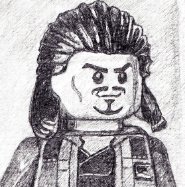
Captain Marvel’s my favorite superhero. Well, most of the time; every now and then Iron Man noses his back to first place. But that’s beside the point.
Carol Danvers first showed up on my radar in 2013’s Infinity event where she was one of the Avengers fighting bad guys in space. It all culminates with, of course, the Avengers back on Earth fighting Thanos. Captain Marvel’s one of the hardest hitters, and it’s positively epic to see her, Thor, and Hulk throwing down with Thanos. I promptly got a hold of all of Kelly Sue DeConnick’s run and the rest is history.
It stands to reason that I was super psyched when they announced Captain Marvel would be getting a movie of her own. And that movie finally came out last week and folks, let me tell you, Captain Marvel is a wonderful joy of a movie.
Part of what makes Captain Marvel work is how well the filmmakers nailed Carol’s character. Carol’s brash and headstrong, the sort who’ll jump first and think later. She’s also a very warm person, someone who frequently tries to do what’s right. And she’s super powerful, what with the flight, super-strength, and ability to shoot photon-blasts.
Her super-powered nature gives her the same issue as writing Superman: How do you make a foe for someone who’s essentially invincible? Now, Carol has her limits, sure, but the real hook to her character comes from her flaws.
Carol is someone who likes to solve problems by punching things. The natural way to give her pause is to provide her with an opponent who can’t be defeated by just punching things. The Skrulls of the movie are shapeshifters, able to assume the guise of a friend or enemy. Since it’s hard to know who’s really the enemy, fighting isn’t the solution. Instead, Carol sets out to find out why the Skrulls are here of all places, a question that, curiously, seems to be deeply entwined with Carol herself.
It’s hard for me to really hash out just how a lot of this works without getting into the plot and spoilers, which, given how new the movie is, I’d rather avoid. So things might get vague here, my apologies. Suffice to say, this movie doesn’t really have a big bad the way that basically every other Marvel movie does. Sure, there are villains, but there isn’t someone who Carol has to punch into submission to win.
The goal of most arcs is to self-actualize, that is to realize one’s potential. In action-y movies that’s usually beating the bad guy, whose role is to be the shadow of the hero, the question of what they could have been were things different. Tony Stark goes up against Obadiah Stane, a someone who would use Stark’s technology for militarization and power. Captain America fights Red Skull, the result of the super-soldier serum used on the wrong person. Their stories are about getting to the point where they can beat that person. In doing so, the hero proves they aren’t like the villain.
Self-actualization can also come from a more quiet place, one that’s often the mark of internal conflicts. Iron Man 2 sees a Tony Stark who struggles with himself and his own mortality. Though Vanko’s the villain, Tony’s primary conflict is with himself and his self-destructive behavior. It’s only when he overcomes that that he’s able to build the Mark VI and fight the bad guy.
Carol’s arc is similar; as an amnesiac who’s known only her life on Hala as part of the Kree Starforce, Earth holds mysteries for her to uncover. She’s trying to figure out why this place is important to her and, with it, who she is. Her fight is with herself, who she thinks she is, who people say she is, and who she really is. She has to first reconcile all that before she can properly fight the bad guys.
Captain Marvel throws all this at our hero, with enough turns to keep her on an off-foot throughout the film. Her awesome powers are balanced with her very real flaws, and the movie successfully translates that character I love from the comics to the screen. Here’s a movie that makes the most powerful character in the MCU still interesting and flawed without compromising her character. Cheers to that, go see it.
And I cannot wait to watch Captain Marvel throw down with Thanos.
- Read more...
- 1 comment
- 710 views

